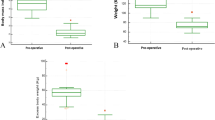Abstract
Background
The volume of the postoperative gastric remnant is a key factor in excess weight loss (EWL) after sleeve gastrectomy (SG). Traditional methods to estimate gastric volume (GV) after bariatric procedures are often inaccurate; usually conventional biplanar contrast studies are used.
Methods
Thirty patients who underwent SG were followed prospectively and evaluated at 6 months after the surgical procedure, performing 3D CT reconstruction and gastric volumetry, to establish its relationship with EWL. The gastric remnant was distended with effervescent sodium bicarbonate given orally. Helical CT images were acquired and reconstructed; GV was estimated with the software of the CT device. The relationship between GV and EWL was analyzed.
Results
The study allowed estimating the GV in all patients. A dispersion diagram showed an inverse relationship between GV and %EWL. 55.5% of patients with GV ≤ 100 ml had %EWL 25–75% and 38.8% had an %EWL above 75% and patients with GV ≥ 100 ml had an %EWL under 25% (50% of patients) or between 25 and 75% (50% of this group). The Pearson’s correlation coefficient was R = 6.62, with bilateral significance (p ≤ .01). The Chi-square result correlating GV and EWL showed a significance of .005 (p ≤ .01). The 3D reconstructions showed accurately the shape and anatomic details of the gastric remnant.
Conclusions
3D volumetry CT scans accurately estimate GV after SG. A significant relationship between GV and EWL 6 months after SG was established, seeming that GV ≥ 100 ml at 6 months of SG is associated with poor EWL.




Similar content being viewed by others
References
Vidal P, Ramón JM, Busto M, et al. Residual gastric volume estimated with a new radiological volumetric model: relationship with weight loss after laparoscopic sleeve gastrectomy. Obes Surg. 2014;24(3):359–63.
Hess DS, Hess DW. Biliopancreatic diversion with a duodenal switch. Obes Surg. 1998;8(3):267–82.
Marceau P, Hould FS, Simard S, et al. Biliopancreatic diversion with duodenal switch. World J Surg. 1998;22(9):947–54.
Boza C, Daroch D, Barros D, et al. Long-term outcomes of laparoscopic sleeve gastrectomy as a primary bariatric procedure. Surg Obes Relat Dis. 2014;10(6):1129–33.
Sleeve gastrectomy as a bariatric procedure. Clinical Issues Committee of American Society for Metabolic and Bariatric Surgery. Surg Obes Relat Dis. 2007;3(6):573–6.
Golomb I, Ben David M, Glass A, et al. Long-term metabolic effects of laparoscopic sleeve gastrectomy. JAMA Surg. 2015;150(11):1051–7.
Braghetto I, Korn O, Valladares H, et al. Laparoscopic sleeve gastrectomy: surgical technique, indications and clinical results. Obes Surg. 2007;17(11):1442–50.
Nocca D, Krawczykowsky D, Bomans B, et al. A prospective multicenter study of 163 sleeve gastrectomies: results at 1 and 2 years. Obes Surg. 2008;18(5):560–5.
Himpens J, Dobbeleir J, Peeters G. Long-term results of laparoscopic sleeve gastrectomy for obesity. Ann Surg. 2010;252(2):319–24.
D’Hondt M, Vanneste S, Pottel H, et al. Laparoscopic sleeve gastrectomy as a single-stage procedure for the treatment of morbid obesity and the resulting quality of life, resolution of comorbidities, food tolerance, and 6-year weight loss. Surg Endosc. 2011;25(8):2498–504.
Weiner RA, Weiner S, Pomhoff I, et al. Laparoscopic sleeve gastrectomy—influence of sleeve size and resected gastric volume. Obes Surg. 2007;17(10):1297–305.
Obeidat FW, Shanti HA, Mismar AA, et al. Volume of resected stomach as a predictor of excess weight loss after sleeve gastrectomy. Obes Surg. 2014;24(11):1904–8.
Pawanindra L, Vindal A, Midha M, et al. Early post-operative weight loss after laparoscopic sleeve gastrectomy correlates with the volume of the excised stomach and not with that of the sleeve! Preliminary data from a multi-detector computed tomography-based study. Surg Endosc. 2015;29(10):2921–7.
Robert M, Pasquer A, Pelascini E, et al. Impact of sleeve gastrectomy volumes on weight loss results: a prospective study. Surg Obes Relat Dis. 2016;12(7):1286–91.
Braghetto I, Davanzo C, Korn O, et al. Scintigraphic evaluation of gastric emptying in obese patients submitted to sleeve gastrectomy compared to normal subjects. Obes Surg. 2009;19(11):1515–21.
Vives M, Molina A, Danús M, et al. Analysis of gastric physiology after laparoscopic sleeve gastrectomy (LSG) with or without antral preservation in relation to metabolic response: a randomised study. Obes Surg. 2017; https://doi.org/10.1007/s11695-017-2700-z.
Karcz WK, Kuesters S, Marjanovic G, et al. 3D-MSCT gastric pouch volumetry in bariatric surgery-preliminary clinical results. Obes Surg. 2009;19(4):508–16.
Blanchet MC, Mesmann C, Yanes M, et al. 3D gastric computed tomography as a new imaging in patients with failure or complication after bariatric surgery. Obes Surg. 2010;20(12):1727–33.
Braghetto I, Cortes C, Herquiñigo D, et al. Evaluation of the radiological gastric capacity and evolution of the BMI 2–3 years after sleeve gastrectomy. Obes Surg. 2009 Sep;19(9):1262–9.
Baumann T, Grueneberger J, Pache G, et al. Three-dimensional stomach analysis with computed tomography after laparoscopic sleeve gastrectomy: sleeve dilation and thoracic migration. Surg Endosc. 2011;25(7):2323–9.
Author information
Authors and Affiliations
Corresponding author
Ethics declarations
Conflict of Interest
The authors declare that they have no conflict of interest.
Ethical Approval
All procedures performed in this study were in accordance with the ethical standards of the institutional research committee and with the 1964 Helsinki declaration and its later amendments.
Informed Consent
Written informed consent was obtained from all the individual participants included in the study.
Rights and permissions
About this article
Cite this article
Hanssen, A., Plotnikov, S., Acosta, G. et al. 3D Volumetry and its Correlation Between Postoperative Gastric Volume and Excess Weight Loss After Sleeve Gastrectomy. OBES SURG 28, 775–780 (2018). https://doi.org/10.1007/s11695-017-2927-8
Published:
Issue Date:
DOI: https://doi.org/10.1007/s11695-017-2927-8




